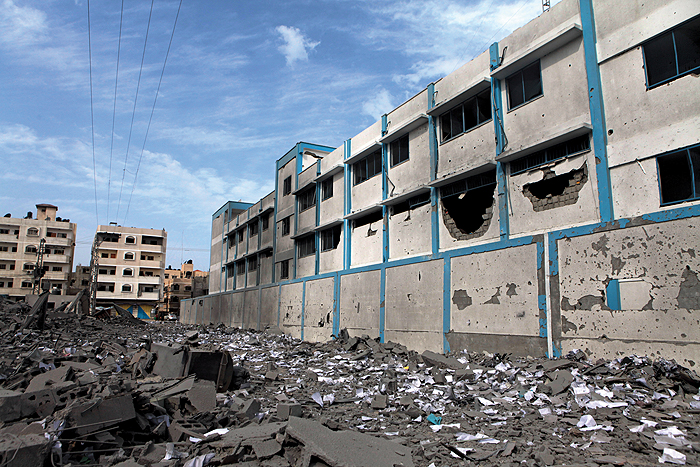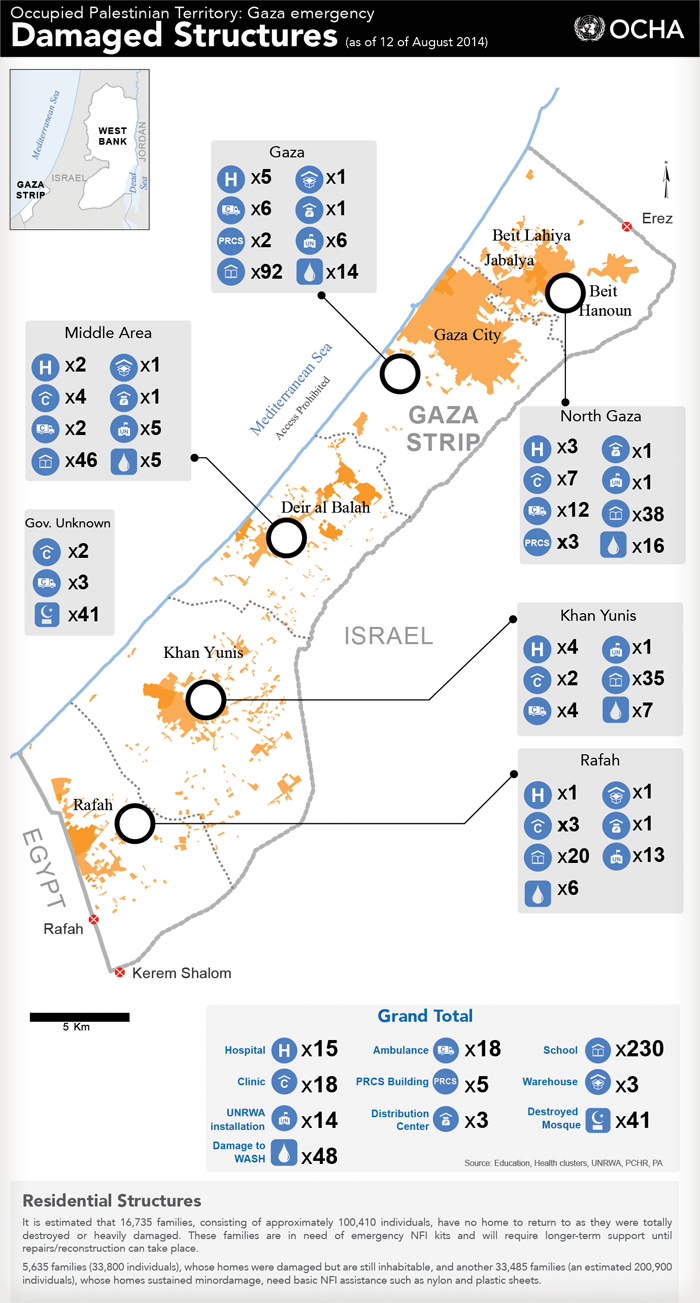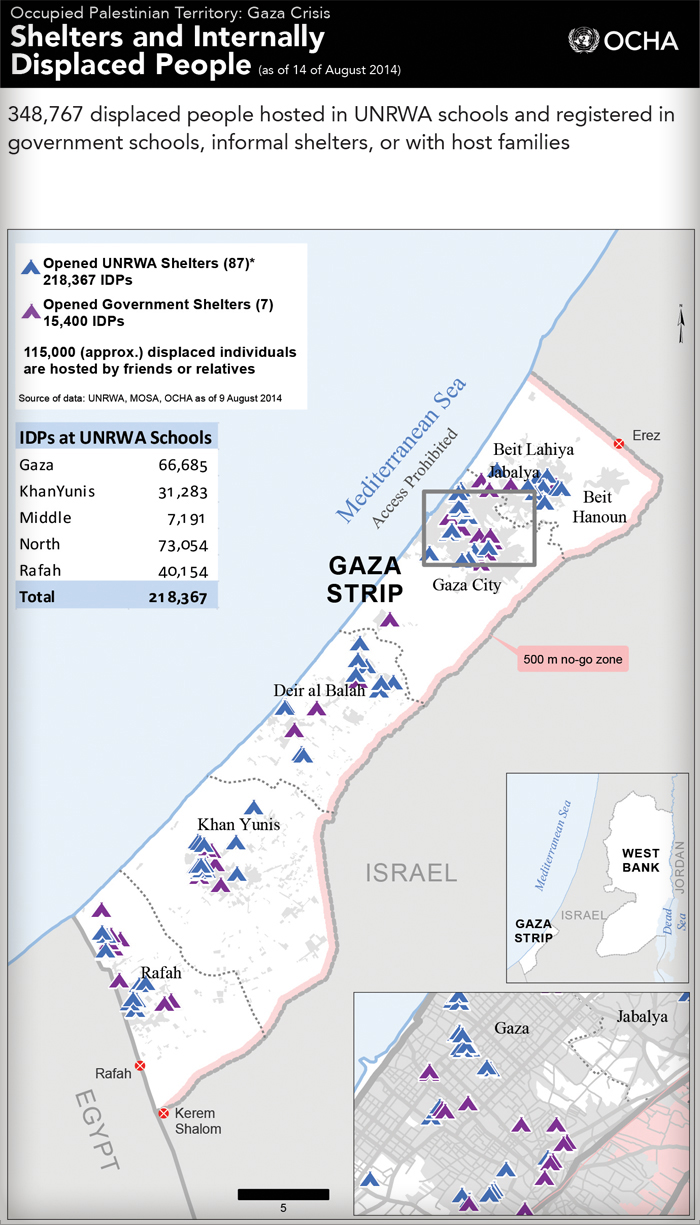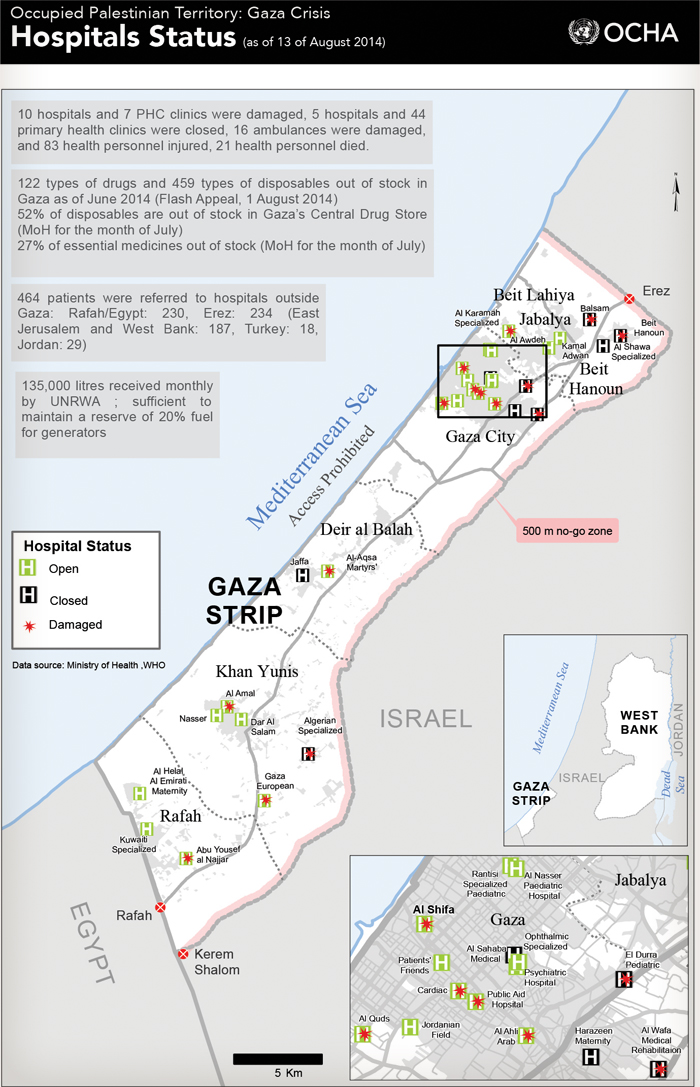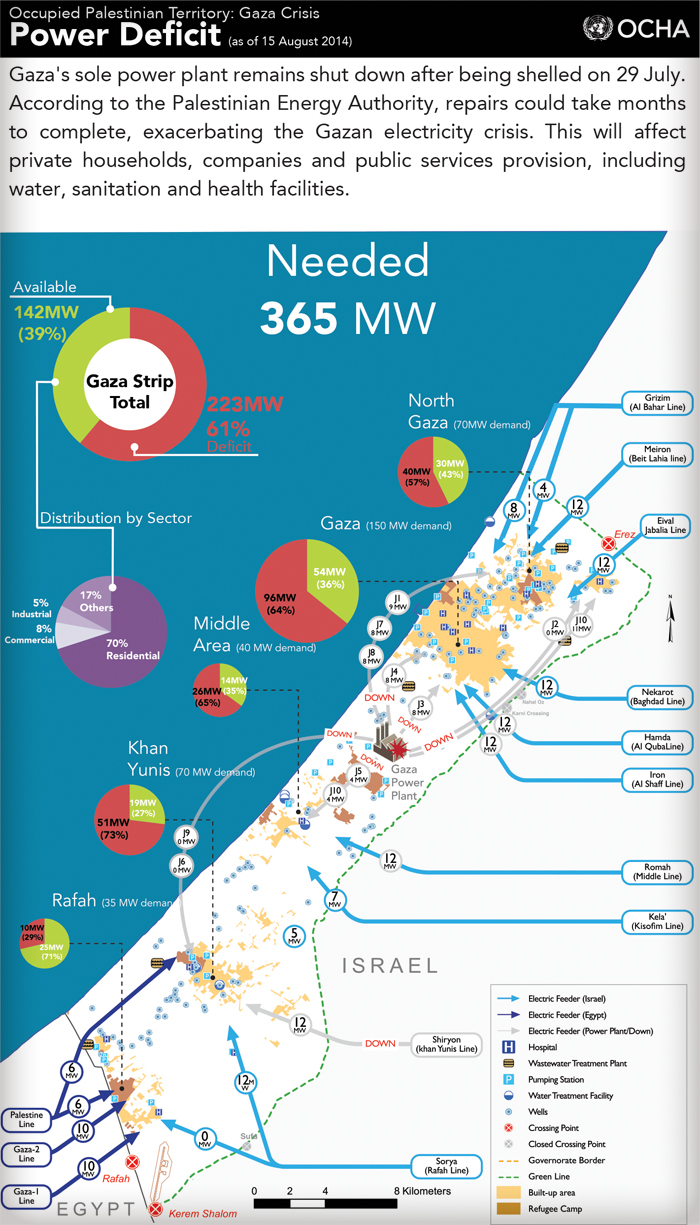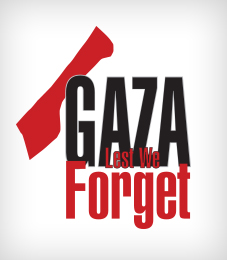August 4, 2014
Although the Israeli military presence has been scaled back in Gaza, hostilities continued for the 27th successive day, resulting in mounting casualties, the continuing destruction of infrastructure, and a rise in internally displaced persons (IDPs). This is adding to the unfolding humanitarian disaster about which senior UN officials warned yesterday, particularly in the health sector. Gaza’s medical services and facilities are nearing collapse, with hospitals and clinics overwhelmed. Critical supplies of medicines and disposables are almost depleted, and the destruction of power supplies has left hospitals dependent on unreliable back-up generators. The status of hospitals and medical facilities as protected objects under international law continues to be violated with more attacks reported since the last situation update (see Infrastructure section below).
Gaza’s sole power plant remains shut down after being shelled on July 29. Repairs may take months to complete, exacerbating the electricity crisis. This affects private households, companies, and public services provision, including water, sanitation, and health facilities. Access to food is also increasingly affected: bakeries cannot meet the additional demand for bread, triggered by the lack of electricity in households, while the inaccessibility of agricultural lands has resulted in fewer fresh crops and a significant increase in prices for some vegetables. There are also reports of fishermen jeopardising their lives by going 50 metres out to sea to feed their families.
Children continue to bear the brunt of the crisis. The number of children killed stands at 373 with at least 2,744 injured. A minimum of 373,000 children require direct and specialised psychosocial support based on the number of families who have experienced death, injury, or loss of home since the beginning of the emergency. Children are showing symptoms of distress and cling to parents, who might also suffer from sleeping and eating disorders, nightmares, nervousness, and feelings of depression, guilt, anger, and helplessness. These conditions worsen with the realisation that there is no guaranteed safe space in Gaza, including UNRWA schools, as underlined again by the attack this morning in Rafah. On six occasions since the start of the conflict, UNRWA schools sheltering the displaced have been subject to shelling.
♦ I watched the missile falling on my home. My home burned. It burned all my toys, my clothes, and my room. I don’t think I’ll survive. A nine-year-old girl from Rafah to an UNRWA counsellor.
Hostilities and casualties
The Rafah area in southern Gaza continues to be the main focus of hostilities, with the Israeli military still present in the area. Rescue workers report recovering over 70 bodies from the area today, but parts of Rafah are still inaccessible because of on-going hostilities. A strike on an UNRWA school in Rafah today, which killed at least nine people, is the seventh incident in which an UNRWA shelter has been hit. The UN Secretary-General, the UN Special Coordinator for the Middle East Peace Process, and the UNRWA Commissioner General have issued separate statements condemning this incident and calling for an independent investigation. Since the last situation update, at least 192 persons have reportedly been killed, though the status of many still needs to be verified. This brings the cumulative death toll among Palestinians to at least 1,717, according to preliminary data collected by the Protection Cluster from various sources, which includes 343 persons (20 percent), who could not be identified or their status established. Of the fatalities whose identity and status could be verified (1,374), nearly 85 percent (1,176 people) are believed to be civilians, including 377 children (27 percent) and 196 women (14 percent), and 14 percent (198) members of armed groups. According to the Palestinian Ministry of Health, 9,078 Palestinians, including 2,744 children, had been injured as of 20:00 on August 2.
♦ The Secretary-General is profoundly dismayed over the appalling escalation of violence and loss of hundreds of Palestinian civilian lives since the breach of the humanitarian ceasefire on August 1. The resurgence in fighting has only exacerbated the man-made humanitarian and health crisis, wreaking havoc in Gaza. Restoring calm can be achieved through resumption of the ceasefire and negotiations by the parties in Cairo to address the underlying issues. Statement attributable to the spokesperson for the Secretary-General on the attack outside an UNRWA shelter, August 3.
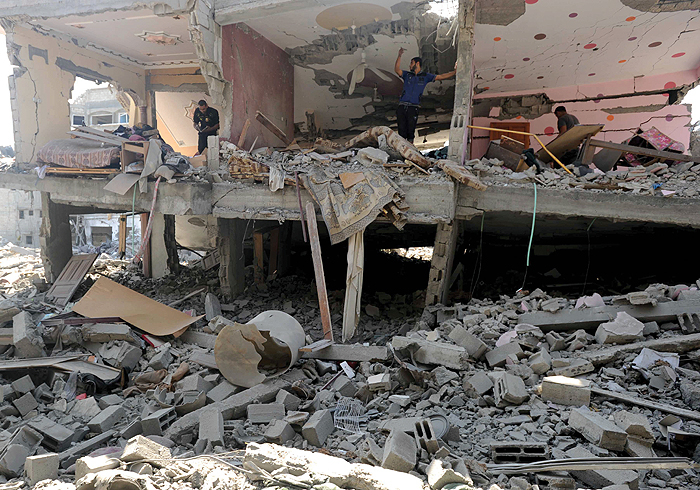
The following are among the most serious incidents recorded during the reporting period.
- August 2, 14:30; the Israeli air force fired at least one missile, destroying the three-storey house, home to five families, of Yousef Dawoud Abu Madi, 68, in Nuseirat Refugee Camp. Six family members were killed, including the owner, his son, and four children. Another 10 people were injured, including three children and four women.
- August 2, 15:00; the Israeli air force bombed the house of Mohammed Ayyad Abu Taha, which is located in Al Shabura Refugee Camp in Rafah. The house was destroyed and four of its residents were killed, including two children and one woman. Another three members of the family were injured.
- August 3, 01:45; the Israeli air force bombed the house of Ahmed Sweelim Al Roumi, 53, which is located in the Al Hashsh neighborhood in Rafah. The house was destroyed and three of the owner’s sons and a daughter – all children – were killed. His wife and two other sons were injured.
- August 3, 06:40; an Israeli aerial attack on the house of Al Ghoul family in Rafah resulted in the killing of eight family members, including two women, three children (1 month, three years, and 13 years old) and injury to seven others.
Since the launch of the Israeli military operation, hundreds of homes have reportedly been directly targeted by Israeli airstrikes, and it is estimated that at least 945 houses have been totally destroyed or severely damaged in this manner, causing civilian casualties, including multiple members of the same families. As of July 30, at least 76 families had lost three or more family members in the same incident, for a total of 407 fatalities. Such cases raise concerns about the targeting of civilians and civilian objects and the launching of indiscriminate attacks. Indiscriminate firing by Palestinian armed groups in Gaza into southern and central Israel continued, with most falling in open areas or intercepted by the Iron Dome system, resulting in no additional fatalities. Since July 8, three civilians in Israel have been killed, including one foreign national, and dozens directly injured by rockets or shrapnel. The number of Israeli military fatalities is now 64, as the soldier who Israeli authorities believed to have been captured on August 1 has officially been declared dead.
Displacement
In the last 24 hours, approximately 10,000 more IDPs are taking shelter in UNRWA schools. As of this afternoon, UNRWA was providing shelter to 269,793 in 90 schools throughout the Gaza Strip. This represents an average of approximately 3,000 IDPs per shelter, which normally have the capacity to accommodate only 500 people. Another 15,741 IDPs are residing in 19 government schools and other institutions, and some 7,000 are reportedly seeking refuge in public buildings/informal shelters. The Ministry of Social Affairs (MoSA) estimates that the number of persons staying with host families throughout the Gaza Strip could be as many as 200,000. The total number of IDPs in Gaza is estimated at approximately 485,000, which represents one-quarter of the Gaza population.
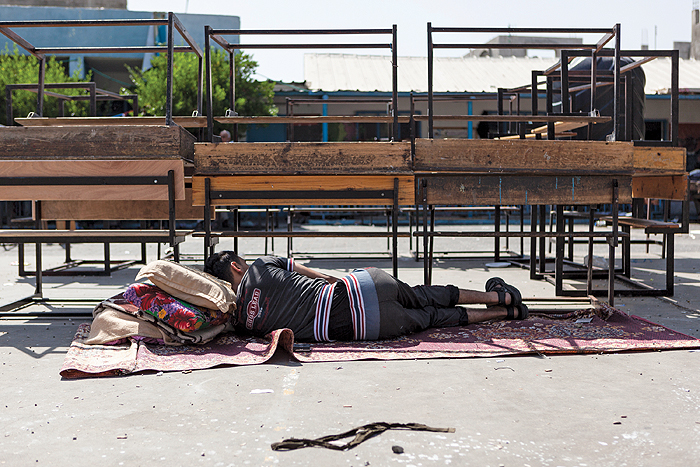
Overcrowding at shelters is challenging the already stretched capacity to provide IDPs with basic necessities, maintain hygiene conditions, and prevent the outbreak of epidemics. While showers in shelters have improved personal hygiene and decreased the risk of spread of disease, an accelerated level of diarrhea has been reported among children. WHO and UNRWA are monitoring health in shelters in order to prevent and control any outbreak of communicable disease.
♦ Hundreds of thousands of people are sheltering in terrible conditions, pushing UNRWA’s coping capacity to the edge. Robert Turner, UNRWA’s Director of Operations in the Gaza Strip, August 2.
Infrastructure and services
In the past 24 hours, an UNRWA school and two government schools have been affected by shelling. In the most serious incident, a missile fired by Israeli forces landed outside the gate of an UNRWA school in Rafah, killing at least nine people, including women and children, and injuring approximately 45. The school was a designated emergency shelter that had been hosting more than 3,000 people displaced by fighting in the area. This is the third occasion in 10 days that a UN school has been hit. Earlier this week, Israeli tank shells struck an UNRWA school in Jabalia, killing at least 15 people, including four children.
♦ The Secretary-General strongly condemns the killing today of at least 10 Palestinian civilians in shelling outside of an UNRWA school in Rafah that provides shelter to thousands of civilians. The attack is yet another gross violation of international humanitarian law, which clearly requires protection by both parties of Palestinian civilians, UN staff, and UN premises, among other civilian facilities… United Nations shelters must be safe zones, not combat zones. The Israel Defence Forces have been repeatedly informed of the location of these sites. This attack, along with other breaches of international law, must be swiftly investigated and those responsible held accountable. It is a moral outrage and a criminal act. Statement attributable to the spokesperson for the Secretary-General on the attack outside an UNRWA shelter, August 3.
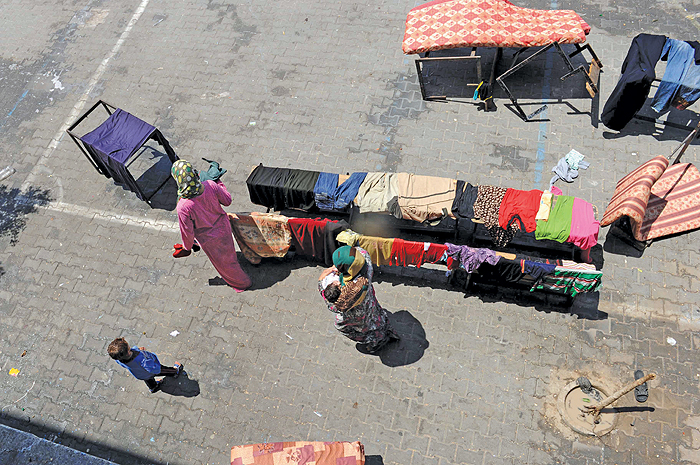
In total, 141 schools (90 UNRWA and 51 government schools) have been affected by shelling due to their close proximity to targeted sites. No information is available on schools in the eastern part of the Gaza Strip and Beit Hanoun, due to the security situation. In the last 24 hours, another government-run kindergarten in West Gaza was affected by shelling, bringing to four the number of kindergartens which have reported significant damage so far, although this number is likely to increase substantially once a full assessment can be conducted. More hospitals reported damage by missiles, rockets, and shrapnel from attacks in their vicinity, and they are also facing shortages of services and staff, as well as fuel and water. According to preliminary information, Al Amal Hospital in Khan Yunis was hit by a missile on August 3, but no details of damage or possible injuries are available. The Cardiac Hospital in Gaza also suffered damage to its cardiac lab, administration building, windows, and an ambulance; one person was injured. The Patients’ Friends Hospital also reported damage to one of its ambulances.
Al Aqsa Hospital, which has been working at 50 percent capacity following an attack on July 21 in which at least three people were killed, reported being hit on the roof on July 30 by a drone missile that caused major damage to the female medical department and injured a nurse. The Gaza European Hospital, located in an area where access has become dangerous, between Rafah and Khan Younis, reported stoppage of its water supplies, forcing the 250-bed hospital to bring a water truck which can supply only 50 percent of its needs. On August 2, its main generator shut down, the daily supply of bread did not reach the hospital, and the laundry services were not working due to the manager being unable to report to work.

